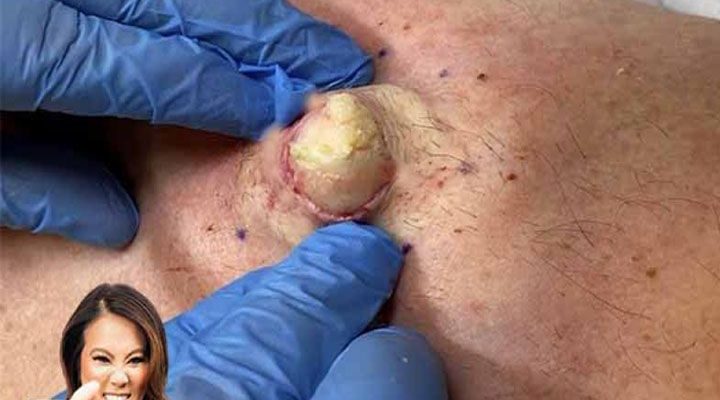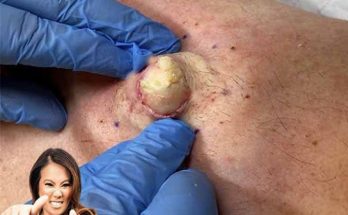Skin cysts and abscesses are common medical conditions that can affect people of all ages. While they may look alarming, these growths are typically benign and treatable with proper medical care. The image above illustrates a professional procedure performed by a healthcare provider, demonstrating the removal of a large sebaceous cyst or abscess from the back of a patient’s neck. Let’s explore what sebaceous cysts are, why they occur, and how medical professionals safely remove them.
What Is a Sebaceous Cyst?
A sebaceous cyst, also known as an epidermoid cyst or epidermal inclusion cyst, is a closed sac that develops under the skin. It forms when the sebaceous gland or hair follicle becomes blocked, causing sebum—a thick, oily substance naturally produced by the body—to accumulate inside. Over time, this buildup creates a lump that can range in size from a small pea to a large marble.
Common areas where these cysts appear include:
-
The scalp
-
Neck
-
Face
-
Back
-
Shoulders
Though sebaceous cysts are typically harmless, they can become painful or infected if bacteria enter the blocked gland.
Causes and Risk Factors
Sebaceous cysts can result from several factors, including:
-
Blocked oil glands or hair follicles
-
Skin trauma such as a scratch or minor injury
-
Genetic conditions like Gardner’s syndrome or basal cell nevus syndrome
-
Hormonal changes that increase oil production
-
Poor hygiene or excessive sweating
Individuals with oily skin are more prone to developing these cysts. Men are also statistically more likely to experience larger sebaceous cysts than women.
Signs and Symptoms
A sebaceous cyst may initially appear as a small, painless lump under the skin. Over time, it can grow and become more noticeable. Common symptoms include:
-
A round, smooth bump beneath the skin
-
A small blackhead or pore at the center of the lump
-
Foul-smelling, cheesy, or yellowish discharge if the cyst bursts
-
Redness, tenderness, and swelling if infection occurs
When the cyst becomes infected, it often turns into an abscess, filled with pus and inflamed tissue, requiring immediate medical treatment.
Medical Treatment and Removal
While small cysts may not need treatment, larger or infected cysts should be handled by a healthcare professional. The image shows a minor surgical procedure where a doctor, wearing sterile gloves, gently squeezes and removes the cyst contents through a small incision. This process involves several key steps:
-
Cleansing the area with an antiseptic to prevent infection.
-
Applying local anesthesia to numb the skin and minimize discomfort.
-
Making a small incision over the cyst.
-
Draining the cyst by expressing its contents, which often appear thick, white, or yellowish.
-
Removing the cyst sac (the wall or capsule) to prevent recurrence.
-
Cleaning and dressing the wound properly.
The entire procedure usually takes less than 30 minutes and provides immediate relief from pressure and pain.
Aftercare and Healing Process
After the cyst removal, proper wound care is essential for recovery. Patients are advised to:
-
Keep the wound clean and dry.
-
Apply prescribed antibiotic ointment.
-
Avoid touching or pressing the healing area.
-
Return for follow-up visits if necessary.
Most patients experience complete healing within 1–2 weeks. Mild redness, swelling, or tenderness may persist temporarily but usually subsides quickly.
Possible Complications
Although cyst removal is a safe procedure, complications can occasionally arise:
-
Infection at the incision site
-
Scarring (usually minimal with skilled surgical technique)
-
Recurrence if the cyst wall is not fully removed
Choosing an experienced healthcare provider greatly reduces these risks.
Prevention Tips
While not all cysts can be prevented, these steps may help reduce the likelihood of recurrence:
-
Maintain good hygiene and exfoliate regularly.
-
Avoid squeezing or picking at cysts or pimples.
-
Use non-comedogenic skincare products to prevent clogged pores.
-
Treat acne and oily skin conditions promptly.
When to See a Doctor
You should seek medical attention if:
-
The lump grows rapidly or becomes painful.
-
There is drainage of pus or foul odor.
-
The skin becomes red, warm, or tender.
-
The cyst returns after prior removal.
Early diagnosis and treatment prevent complications and speed up recovery.
Conclusion
Sebaceous cysts and abscesses are common but manageable skin conditions. Professional removal, as shown in the image, ensures a safe and effective outcome while minimizing the risk of recurrence. Maintaining good skincare habits and seeking timely medical care are essential for healthy, clear skin.
By understanding the causes, symptoms, and treatment of sebaceous cysts, individuals can make informed decisions about their skin health and prevent minor issues from developing into more serious infections.

